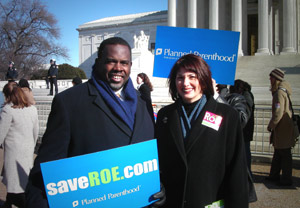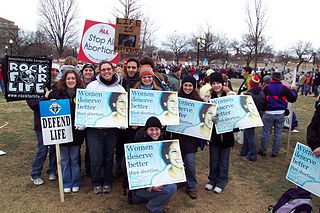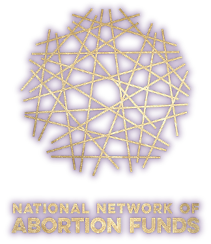Related Research Articles

The United States abortion-rights movement is a sociopolitical movement in the United States supporting the view that a woman should have the legal right to an elective abortion, meaning the right to terminate her pregnancy, and is part of a broader global abortion-rights movement. The movement consists of a variety of organizations, with no single centralized decision-making body.
The Planned Parenthood Federation of America, Inc. (PPFA), or simply Planned Parenthood, is a nonprofit organization that provides reproductive and sexual healthcare, and sexual education in the United States and globally. It is a tax-exempt corporation under Internal Revenue Code section 501(c)(3) and a member association of the International Planned Parenthood Federation (IPPF).

A self-induced abortion is an abortion performed by the pregnant woman herself, or with the help of other, non-medical assistance. Although the term includes abortions induced outside of a clinical setting with legal, sometimes over-the-counter medication, it also refers to efforts to terminate a pregnancy through alternative, potentially more dangerous methods. Such practices may present a threat to the health of women.
Rust v. Sullivan, 500 U.S. 173 (1991), was a case in the United States Supreme Court that upheld Department of Health and Human Services regulations prohibiting employees in federally funded family-planning facilities from counseling a patient on abortion. The department had removed all family planning programs that involving abortions. Physicians and clinics challenged this decision within the Supreme Court, arguing that the First Amendment was violated due to the implementation of this new policy. The Supreme Court, by a 5–4 verdict, allowed the regulation to go into effect, holding that the regulation was a reasonable interpretation of the Public Health Service Act, and that the First Amendment is not violated when the government merely chooses to "fund one activity to the exclusion of another."

A crisis pregnancy center (CPC), sometimes called a pregnancy resource center (PRC) or a pro-life pregnancy center, is a type of nonprofit organization established by anti-abortion groups primarily to persuade pregnant women against having an abortion. In the United States, CPCs that qualify as medical clinics may also provide pregnancy testing, sonograms, and other services, while many others operate without medical licensing under varying degrees of regulation. CPCs have frequently been found to disseminate false medical information about the supposed physical and mental health risks of abortion, and sometimes promulgate misinformation about the effectiveness of condoms and prevention of sexually transmitted infections. CPCs are sometimes referred to as fake abortion clinics by scholars, the media, and supporters of abortion rights, due to deceptive advertising practices that obscure the anti-abortion agenda of CPCs from potential patients seeking abortions.

The United States anti-abortion movement contains elements opposing induced abortion on both moral and religious grounds and supports its legal prohibition or restriction. Advocates generally argue that human life begins at conception and that the human zygote, embryo or fetus is a person and therefore has a right to life. The anti-abortion movement includes a variety of organizations, with no single centralized decision-making body. There are diverse arguments and rationales for the anti-abortion stance. Some anti-abortion activists allow for some permissible abortions, including therapeutic abortions, in exceptional circumstances such as incest, rape, severe fetal defects, or when the woman's health is at risk.
Menstrual extraction (ME) is a type of manual vacuum aspiration technique developed by feminist activists Lorraine Rothman and Carol Downer to pass the entire menses at once. The non-medicalized technique has been used in small feminist self-help groups since 1971 and has a social role of allowing access to early abortion without needing medical assistance or legal approval. ME usage declined after 1973, when Roe v. Wade legalized abortion in the United States. There has been renewed interest in the technique, in the 1990s and more recently in the 2010s, due to increased restrictions on abortion. In some countries where abortion is illegal, such as Bangladesh, the terms "menstrual regulation" or "menstrual extraction" are used as euphemisms for early pregnancy terminations.
In U.S. politics, the Hyde Amendment is a legislative provision barring the use of federal funds to pay for abortion, except to save the life of the woman, or if the pregnancy arises from incest or rape. Before the Hyde Amendment took effect in 1980, an estimated 300,000 abortions were performed annually using federal funds.
This is a timeline of reproductive rights legislation, a chronological list of laws and legal decisions affecting human reproductive rights. Reproductive rights are a sub-set of human rights pertaining to issues of reproduction and reproductive health. These rights may include some or all of the following: the right to legal or safe abortion, the right to birth control, the right to access quality reproductive healthcare, and the right to education and access in order to make reproductive choices free from coercion, discrimination, and violence. Reproductive rights may also include the right to receive education about contraception and sexually transmitted infections, and freedom from coerced sterilization, abortion, and contraception, and protection from practices such as female genital mutilation (FGM).
The Title X Family Planning Program is the only federal grant program dedicated to providing individuals with comprehensive family planning and related preventive health services. It was enacted under President Richard Nixon in 1970 as part of the Public Health Service Act.
The Stupak–Pitts Amendment was a proposed amendment to the Affordable Health Care for America Act of 2010 (AHCAA). It was submitted by Representatives Bart Stupak and Joseph R. Pitts. Its stated purpose was to prohibit the use of federal funds "to pay for any abortion or to cover any part of the costs of any health plan that includes coverage of abortion" except in cases of rape, incest or danger to the life of the mother. It was adopted by the House but not included in the Senate's version, the Patient Protection and Affordable Care Act (PPACA). Representatives who support abortion rights said they would oppose AHCAA with the Stupak-Pitts language, and proposed to adopt PPACA. Stupak and several supporters said they would oppose PPACA without the amendment, but withdrew their opposition after President Obama promised an executive order to bar such funding. Anti-abortion groups criticized this action, saying that the executive order would not be effective.

Birth control in the United States is available in many forms. Some of the forms available at drugstores and some retail stores are male condoms, female condoms, sponges, spermicides, and over-the-counter emergency contraception. Forms available at pharmacies with a doctor's prescription or at doctor's offices are oral contraceptive pills, patches, vaginal rings, diaphragms, shots/injections, cervical caps, implantable rods, and intrauterine devices (IUDs). Sterilization procedures, including tubal ligations and vasectomies, are also performed.
Abortion is the termination of human pregnancy, often performed in the first 28 weeks of pregnancy. In 1973, the United States Supreme Court in Roe v. Wade recognized a constitutional right to obtain an abortion without excessive government restriction, and in 1992 the Court in Planned Parenthood v. Casey invalidated restrictions that create an undue burden on people seeking abortions. Since then, there has continued to be an abortion debate in the United States, and some states have passed laws in the form of regulation of abortions but which have the purpose or effect of restricting its provision. The proponents of such laws argue they do not create an undue burden. Some state laws that impact the availability of abortions have been upheld by courts. In 2022, Roe and Casey were overturned by the Supreme Court in Dobbs v. Jackson Women's Health Organization, meaning that states may now regulate abortion in ways that were not previously permitted.
A medical abortion, also known as medication abortion, occurs when drugs (medication) are used to bring about an abortion. Medical abortions are an alternative to surgical abortions such as vacuum aspiration or dilation and curettage. Medical abortions are more common than surgical abortions in most places, including Europe, India, China, and the United States.

Maternal healthcare in Texas refers to the provision of family planning services, abortion options, pregnancy-related services, and physical and mental well-being care for women during the prenatal and postpartum periods. The provision of maternal health services in each state can prevent and reduce the incidence of maternal morbidity and mortality and fetal death.
Abortion in Texas is illegal in most cases. A trigger law has been in effect since August 25, 2022, which bans abortion in all cases except to save the life of the mother.
Abortion in Hawaii is legal. 66% of adults in Hawaii said in a poll by the Pew Research Center that abortion should be legal in all or most cases. Hawaii began allowing elective abortion care de jure in 1970, the first state to do so. State law enacted at that time stated said, "the State shall not deny or interfere with a female's right to choose or obtain an abortion of a nonviable fetus or an abortion that is necessary to protect the life or health of the female."
Elective abortions in Wisconsin became illegal after the overturning of Roe v. Wade by the Supreme Court of the United States on June 24, 2022. An 1849 law bans the procedure in all cases except when the life of the mother is in danger. The enforceability of the law is disputed and being considered by the state courts.
Abortion in Maryland is legal up to the point of fetal viability and later when necessary to preserve the life or health of the pregnant person. The first laws regulating abortion in the state were passed in 1867 and 1868, banning abortion except by a physician to "secure the safety of the mother." Abortion providers continued to operate both within and outside of the law. Legal enforcement became more strict from the 1940s through 60s, with numerous police raids on abortion providers. In 1968, Maryland passed a liberalized abortion law that clarified the wording of the previous law, allowing abortion in hospital settings in cases of rape, severe fetal deformity, or when life and health were endangered.

The National Network of Abortion Funds (NNAF) is a national social justice organization that aims to increase access to abortion for low-income people across the U.S.
References
- 1 2 3 4 5 6 7 "Common Questions About Abortion Funds". National Network of Abortion Funds. Retrieved 2019-07-16.
- 1 2 3 4 Towey S, Poggy S, and Roth R (2005). Abortion funding: A matter of justicity. Amherst, MA: National Network of Abortion Funds.
- 1 2 Ely, GE; Hales, T; Jackson, DL; Maguin, E; Hamilton, G (2017). "The undue burden of paying for abortion: An exploration of abortion fund cases". Social Work in Health Care. 56 (2): 99–114. doi:10.1080/00981389.2016.1263270. ISSN 0098-1389. PMID 27960652. S2CID 3535883.
- ↑ Stewart, Nikita (2019-06-14). "New York City Allocates $250,000 for Abortions, Challenging Conservative States". The New York Times. ISSN 0362-4331 . Retrieved 2019-07-09.
- ↑ "Justice Fund". www.plannedparenthood.org. Archived from the original on 2020-07-28. Retrieved 2020-08-18.
- ↑ "Can I get a discount at my clinic?". National Network of Abortion Funds. Retrieved 2020-08-18.
- 1 2 prochoice. "NAF Hotline Fund". National Abortion Federation. Retrieved 2020-08-18.
- ↑ "Women's Reproductive Rights Assistance Project (WRRAP)". National Network of Abortion Funds. Retrieved 2020-08-18.
- ↑ "hotlines and regional resources for family planning, abortion, and activism". Women Help Women Consultation. Retrieved 2020-08-18.
- ↑ "An Overview of Abortion Laws". Guttmacher Institute. July 1, 2019.
- ↑ Aizenman, Nurith (13 June 2018). "Trump's Ban On Funding For Overseas Abortions Has Some Little-Known Exceptions". NPR.org. Retrieved 2020-08-18.
- ↑ "Support with abortion". Safe Abortion Action Fund. Retrieved 2020-08-18.[ permanent dead link ]
- 1 2 Jones, RK; Ingerick, M; Jerman, J (2018). "Differences in Abortion Service Delivery in Hostile, Middle-ground, and Supportive States in 2014". Women's Health Issues. 28 (3): 212–218. doi:10.1016/j.whi.2017.12.003. PMC 5959790 . PMID 29339010.
- 1 2 3 4 Roberts, SCM; Gould, H; Kimport, Katrina; Weitz, TA; Foster, DG (2014). "Out-of-Pocket Costs and Insurance Coverage for Abortion in the United States". Women's Health Issues. 24 (2): e211–e218. doi:10.1016/j.whi.2014.01.003. PMID 24630423.
- ↑ Jones, RK; Upadhyay, UD; Weitz, TA (2013). "At What Cost? Payment for Abortion Care by U.S. Women". Women's Health Issues. 23 (3): e173–e178. doi: 10.1016/j.whi.2013.03.001 . PMID 23660430.
- 1 2 Jerman, Jenna; Jones, Rachel K.; Onda, Tsuyoshi (2016-05-10). "Characteristics of U.S. Abortion Patients in 2014 and Changes Since 2008".
{{cite journal}}: Cite journal requires|journal=(help) - 1 2 Cain, Briscoe (March 18, 2022). "State Representative Briscoe Cain Sends Cease-And-Desist Letters to Abortion Funds in Texas". twitter.com. Retrieved June 15, 2022.
- ↑ Klibanoff, Eleanor (March 29, 2022). "Abortion nonprofits say Texas state Rep. Briscoe Cain defamed them in "cease-and-desist" letter". texastribune.com. Retrieved June 15, 2022.